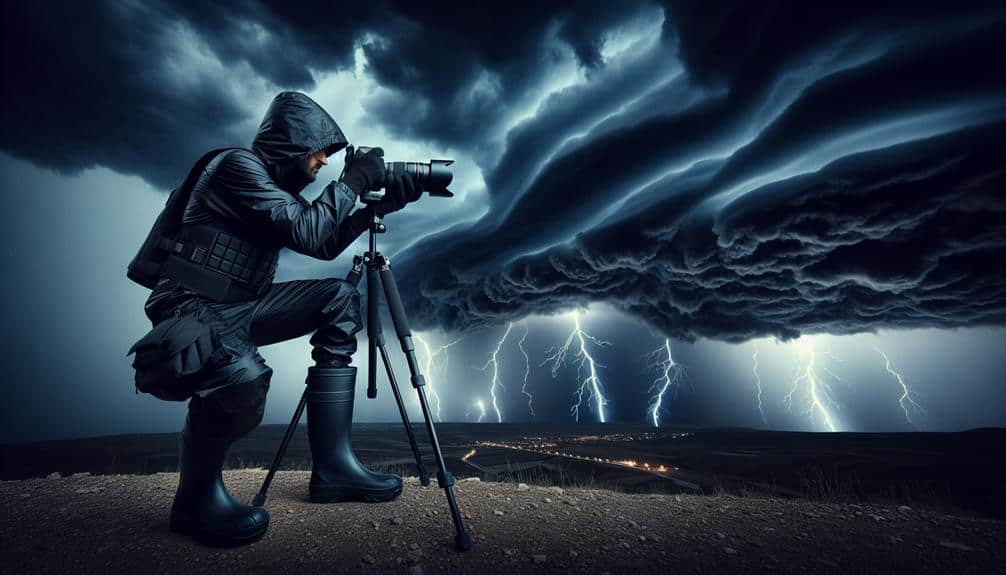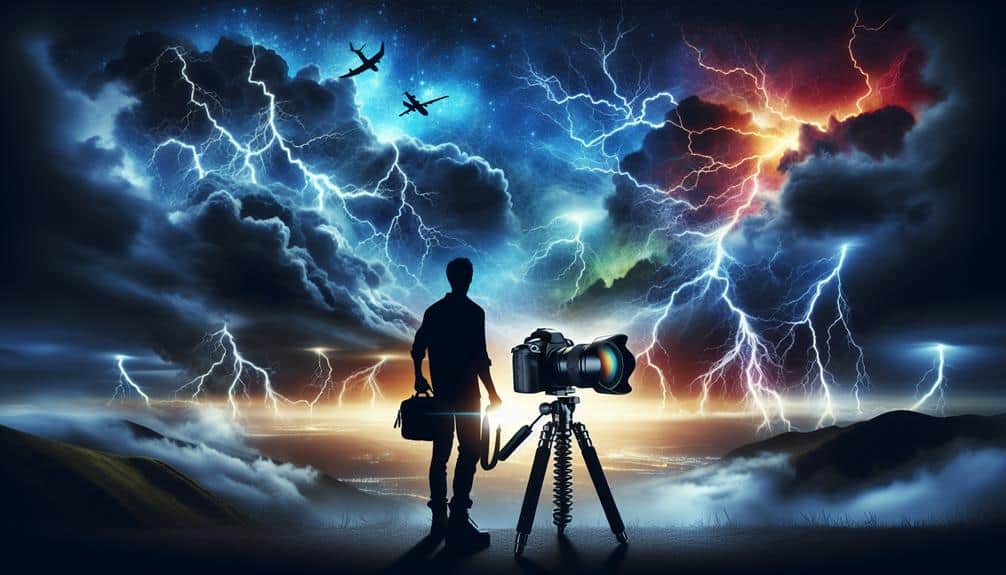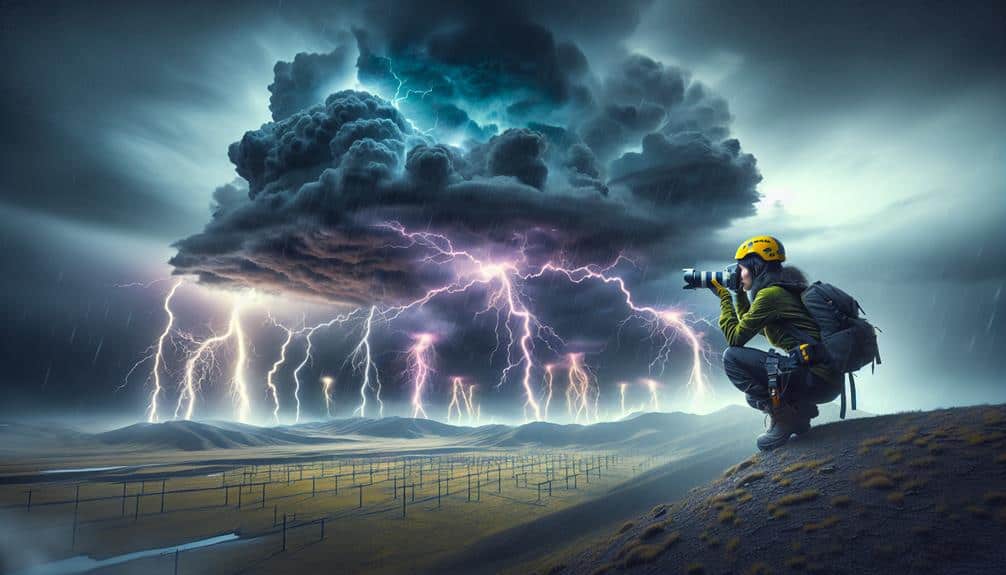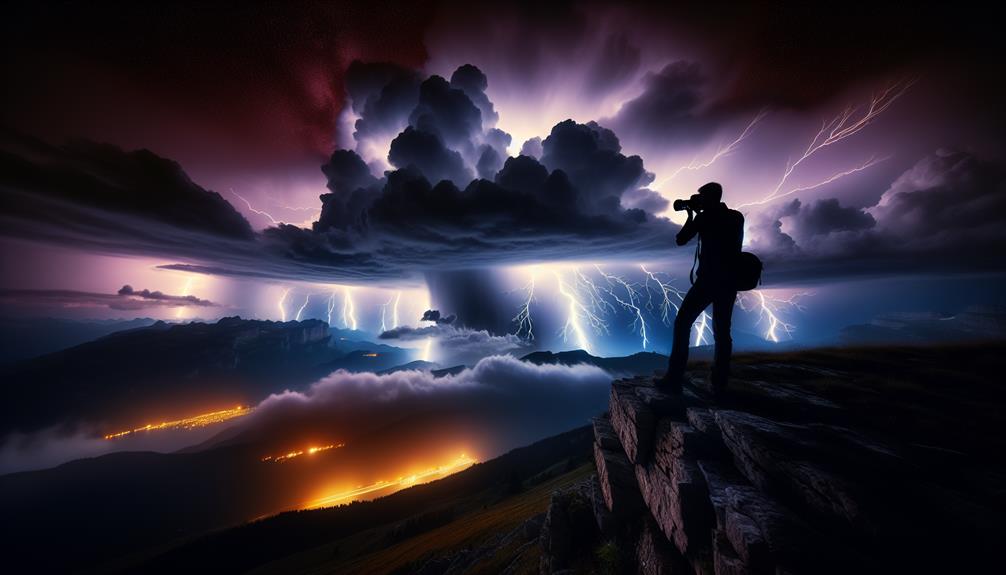We must prioritize safety precautions in lightning photography due to the immense power and unpredictability of lightning strikes, which can release up to a billion volts of electricity. By evaluating risks and selecting safe locations, such as open areas away from conductive structures, we reduce potential dangers. Using weatherproof camera gear and real-time storm monitoring tools, we stay ready and protected. Wearing insulated clothing and having emergency plans also guarantee our safety. By balancing technical precision with instinctive responses, we not only capture stunning images but do so securely. Stay with us as we delve into these safety measures in depth.
Key Points
- Lightning strikes can release up to a billion volts, posing a severe risk to photographers.
- Proper safety measures prevent potential injuries from unpredictable weather patterns during lightning photography.
- Insulated, waterproof clothing and non-conductive gear minimize the risk of electrical contact.
- Real-time weather updates and monitoring tools help avoid dangerous storm conditions.
Understanding Lightning Risks
Understanding the risks associated with lightning is paramount for any photographer aiming to capture its raw beauty without compromising safety. As artists driven by the pursuit of extraordinary images, we can't ignore the inherent lightning dangers that accompany this endeavor.
Lightning is immensely powerful and unpredictable, making risk assessment a critical component of our preparation. When we consider lightning dangers, we need to understand that a single strike can release up to a billion volts of electricity, posing severe threats to our well-being.
By conducting a thorough risk assessment, we can evaluate the likelihood and impact of these hazards. This involves keeping abreast of weather forecasts, understanding storm patterns, and knowing lightning's behavior in different environments.
Our approach should be both technical and instinctive, combining meteorological data with an intuitive sense of nature's movements. We must recognize that lightning can strike miles away from the storm's center, making distance a deceptive measure of safety.
In our pursuit of freedom and creativity, knowledge becomes our strongest ally. By mastering the art of risk assessment, we can embrace the storm's grandeur while safeguarding our lives.
Choosing Safe Locations
Selecting the right location is important for safely capturing lightning's majesty, requiring thorough evaluation of terrain, shelter availability, and distance from conductive structures.
When we commence on location scouting, we must prioritize safety tips alongside our creative vision. A safe distance from tall, isolated objects like trees and metal structures is vital to minimize the risk of lightning strikes.
We should aim for open areas where we can maintain a clear view of the sky without being the tallest point in the vicinity. Coastal regions, plains, and large fields often provide excellent vantage points. However, it's crucial to ensure that we've quick access to a sturdy shelter, such as a car or a building, to retreat to if the storm intensifies.
While the allure of capturing a perfect shot tempts us to push boundaries, our safety can't be compromised. Utilizing weather apps and lightning detection tools can help us monitor storm activity and avoid dangerous situations.
Proper Equipment Setup
When setting up our equipment for lightning photography, we must have a sturdy tripod to handle the elements and prevent camera shake.
Using weatherproof camera gear is essential to protect our investment from the harsh conditions.
Additionally, employing lens protection strategies, such as UV filters or lens hoods, can shield our optics from water and debris, guaranteeing clear, sharp images.
Sturdy Tripod Selection
To capture the perfect lightning shot, we need a sturdy tripod that minimizes vibrations and withstands adverse weather conditions. Tripod stability is paramount when dealing with the unpredictable and often intense environment of lightning photography.
Lightweight tripods may be convenient for travel, but they often sacrifice stability. We should opt for a robust model, made from high-quality materials like carbon fiber or aluminum, to guarantee our setup remains rock-solid even in gusty winds.
Equally important is equipment durability. A tripod that can endure the elements will keep our camera safe and secure during those critical moments. Look for features like weather-resistant locks and anti-slip feet, which provide additional grip on uneven or slick surfaces.
These features not only enhance stability but also extend the lifespan of our gear, making them a wise investment for any serious photographer.
Weatherproof Camera Gear
While a sturdy tripod provides a solid foundation, our camera gear must also be weatherproof to withstand the harsh conditions often encountered during lightning photography.
A waterproof camera is essential; it guarantees that our equipment remains functional despite the relentless rain and unpredictable weather typical of storm environments. Selecting a camera specifically designed to resist water damage can be the distinction between capturing that perfect lightning shot and dealing with costly repairs or replacements.
We must also consider the durability of our gear in extreme wind conditions. High winds often accompany thunderstorms, and gear that isn't robust enough can suffer damage or even be lost in the tumult. Investing in weather-sealed bodies and lenses is a wise decision. These features offer added protection against not just water, but also dust and debris, which are prevalent during storms.
Moreover, thinking about lightning safety is essential. We need to guarantee that our setup is both secure and quick to maneuver in case we need to take cover suddenly.
Quick-release mechanisms on our tripods and waterproof camera bags allow us to pack up swiftly, securing our safety and preserving our valuable equipment.
Lens Protection Strategies
Safeguarding our lenses from the harsh elements during lightning photography is crucial for preserving image quality and prolonging the lifespan of our gear. One key strategy involves utilizing a UV filter. This uncomplicated yet efficient accessory acts as a shield against dust, moisture, and accidental scratches.
By affixing a UV filter to our lens, we protect the front element without compromising the clarity of our shots.
Equally vital is the utilization of a lens hood. A well-crafted lens hood not only diminishes lens flare and boosts contrast but also provides added defense against rain and debris. When capturing lightning, the final thing we desire is water droplets obscuring our view of the storm.
A lens hood assists in safeguarding the lens from these intrusions, enabling us to concentrate solely on capturing that flawless strike.
Arranging our equipment with these protective measures guarantees that our creative liberty isn't hindered by environmental obstacles. We can fully engage in the artistry of lightning photography, assured that our gear is protected against potential hazards.
In this manner, we attain both technical accuracy and artistic excellence, upholding the integrity of our images and equipment equally.
Monitoring Weather Conditions
To capture lightning safely and effectively, we must prioritize monitoring weather conditions. Utilizing real-time weather updates and storm tracking tools allows us to position ourselves efficiently without compromising safety.
Additionally, weather alert systems can provide critical warnings, ensuring we stay informed of any sudden changes.
Real-time Weather Updates
Accurate real-time weather updates are essential for lightning photographers to guarantee both safety and ideal shooting conditions. As it's common knowledge, lightning safety is paramount when capturing these electrifying moments.
By carefully monitoring weather conditions, we can't only prevent potentially life-threatening situations but also optimize our chances of obtaining breathtaking shots.
Weather monitoring involves staying informed about atmospheric changes, storm developments, and lightning activity in our vicinity. With access to real-time weather data, we can make informed decisions about when and where to set up our equipment. This ensures that we're always a step ahead, avoiding unnecessary risks while still chasing the perfect shot.
We rely on sophisticated weather monitoring systems to provide us with timely alerts about approaching storms. These systems offer detailed insights into storm intensity, movement, and potential hazards.
By leveraging this information, we maintain a balance between our artistic pursuits and our well-being. Understanding and utilizing real-time weather updates empowers us to capture the raw beauty of lightning while safeguarding that our safety isn't compromised.
With the right tools and knowledge, we can embrace the freedom to explore our passion responsibly.
Storm Tracking Tools
Utilizing advanced storm monitoring tools is essential for lightning photographers to monitor weather conditions effectively and ensure their safety. By harnessing these technologies, we can pinpoint lightning activity and discern intricate weather patterns with precision. Tools like lightning detection systems provide real-time data on lightning strikes, allowing us to anticipate the storm's behavior and plan our shots without compromising safety.
Storm monitoring apps and radar systems offer detailed insights into developing weather scenarios. These tools enable us to visualize storm movements and predict their trajectories, ensuring we're not caught off-guard by sudden changes. For those of us looking to capture the perfect lightning shot, understanding these patterns isn't just beneficial—it's critical.
Moreover, integrating satellite imagery and Doppler radar can enhance our understanding of storm dynamics. By analyzing this data, we can identify high-risk areas and times, making informed decisions on when and where to set up our equipment. This blend of artistic insight and technical precision allows us to capture nature's raw power while retaining our freedom to explore and create safely.
In essence, storm monitoring tools are indispensable for navigating the unpredictable nature of lightning photography, merging safety with the thrill of the chase.
Weather Alert Systems
Effective weather alert systems are our lifeline in lightning photography, providing timely warnings that help us navigate volatile conditions. Accurate lightning detection is essential for capturing the perfect shot while securing our outdoor safety. By leveraging advanced radar technology and satellite data, these systems offer real-time updates on storm development and lightning activity.
We can't emphasize enough the importance of integrating weather alert systems into our photography routine. These tools allow us to monitor evolving weather patterns and make informed decisions about when and where to set up our equipment. Apps and websites dedicated to storm tracking offer customizable alerts, ensuring we receive essential information directly to our devices.
For those of us seeking the thrill of photographing lightning, freedom doesn't mean taking unnecessary risks. Instead, it involves using precise, reliable tools to pursue our passion safely. Investing in a dependable weather alert system secures that we can fully immerse ourselves in the creative process, knowing we're well-informed about potential dangers.
In essence, combining our artistic vision with technical precision through the use of advanced weather alert systems allows us to embrace outdoor photography without compromising our safety.
Protective Clothing and Gear

When capturing the dramatic spectacle of lightning, we should prioritize wearing insulated, waterproof clothing and sturdy rubber-soled boots to minimize the risk of electrical conduction. Protective gear is crucial to guarantee our safety amidst the raw power of a thunderstorm. Our clothing selection matters immensely, as it can be the difference between a safe experience and a hazardous one.
High-quality, durable materials are a must. Let's consider some key items:
- Insulated, Waterproof Jackets: These shield us from rain and help insulate against potential electrical currents.
- Rubber-Soled Boots: Essential for grounding and reducing the risk of electrical shock.
Maintaining our gear is just as important as selecting it. Regular inspections for wear and tear, cleaning with appropriate methods, and ensuring waterproofing remains effective are all crucial steps. Protective gear isn't just about immediate safety; it's about long-term reliability.
When we're out in the field, the last thing we want is to discover a critical piece of equipment has failed. By prioritizing proper clothing selection and diligent gear maintenance, we can safely embrace the freedom and artistry of lightning photography.
Emergency Procedures
In the unpredictable setting of a thunderstorm, we must always be ready to execute emergency procedures swiftly and efficiently. Knowing our evacuation routes is crucial. We need to identify multiple paths to safety before setting up our gear. These routes should be clear of obstacles and provide the quickest escape from hazardous conditions.
Emergency contacts are another vital aspect. We should have a list of contacts, including local emergency services, family, and fellow photographers. This ensures that help is just a call away if the situation escalates.
Our first aid kit is non-negotiable. It should contain basic medical supplies like bandages, antiseptics, and pain relievers. In the event of an injury, administering immediate medical assistance can prevent further complications.
We should also be familiar with basic first aid procedures, such as CPR, to handle any unforeseen medical emergencies.
Frequently Asked Questions
Can Lightning Photography Damage My Camera?
Yes, lightning photography can damage our cameras if we don't prioritize camera protection and equipment care. High voltage surges and extreme weather can harm sensitive electronics, so let's make sure our gear is safeguarded for peak performance.
How Do I Capture Lightning Without a Remote Trigger?
Capturing lightning without a remote trigger is like catching fireflies in a jar. We can use manual timing or an intervalometer. Experiment with creative angles and composition to achieve breathtaking shots that showcase our artistic vision and technical skills.
What Settings Should I Use for Nighttime Lightning Photography?
For nighttime settings, let's set a low ISO (100-400) to reduce noise, use a small aperture (f/8-f/11) for depth of field, and expose for 10-30 seconds. These exposure tips help capture stunning lightning shots.
Is Post-Processing Important for Lightning Photos?
Isn't it a coincidence that great lightning photos often shine with post-processing? We rely on editing techniques to enhance lighting effects, ensuring every detail pops. Let's harness our creativity to elevate those raw captures into stunning masterpieces.
Can I Use a Smartphone for Lightning Photography?
We can use a smartphone for lightning photography, but smartphone limitations like sensor size and shutter speed reduce quality. Equipment alternatives like DSLRs or mirrorless cameras offer better control and precision, giving us the freedom to capture stunning shots.


